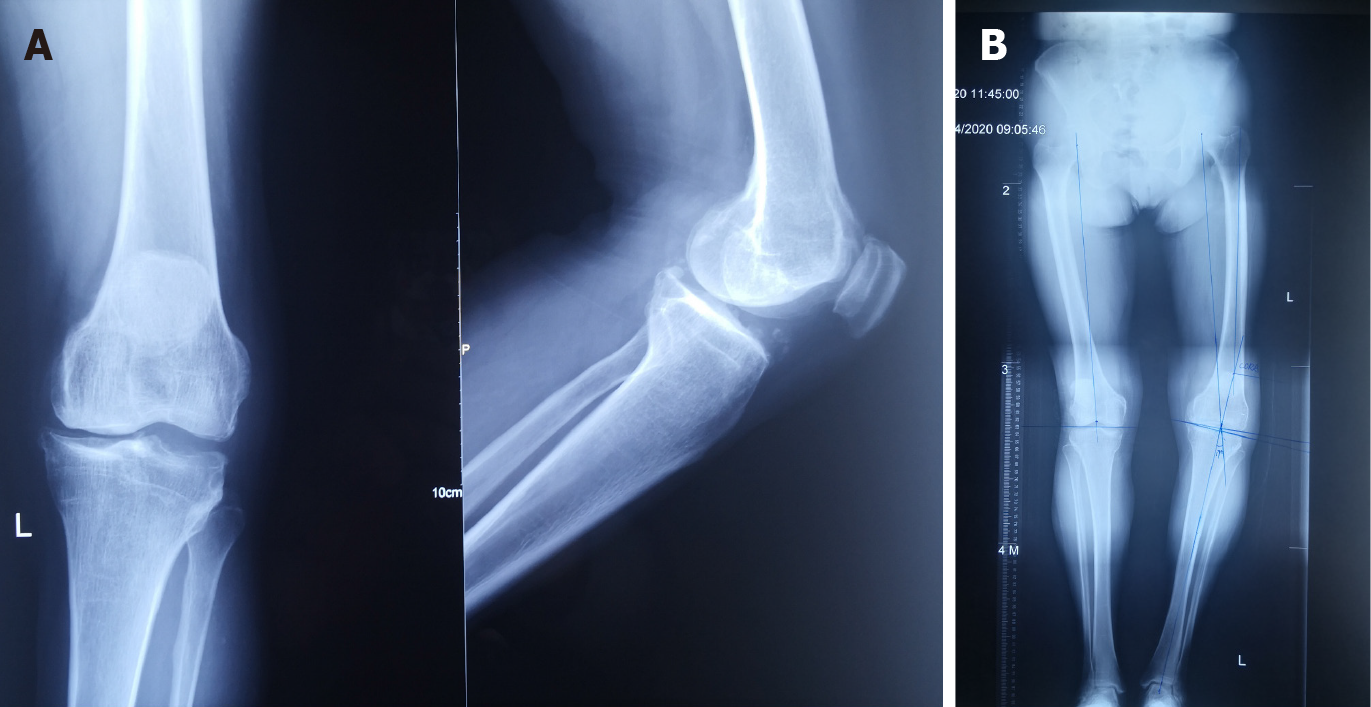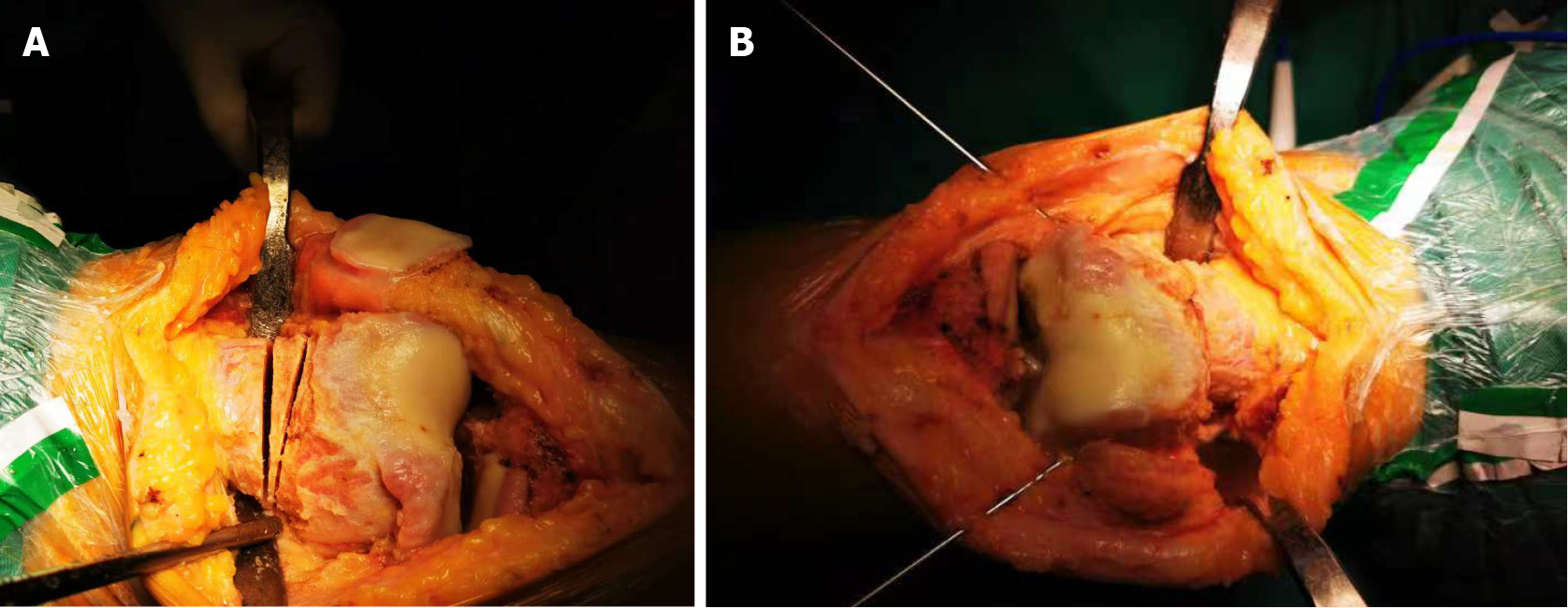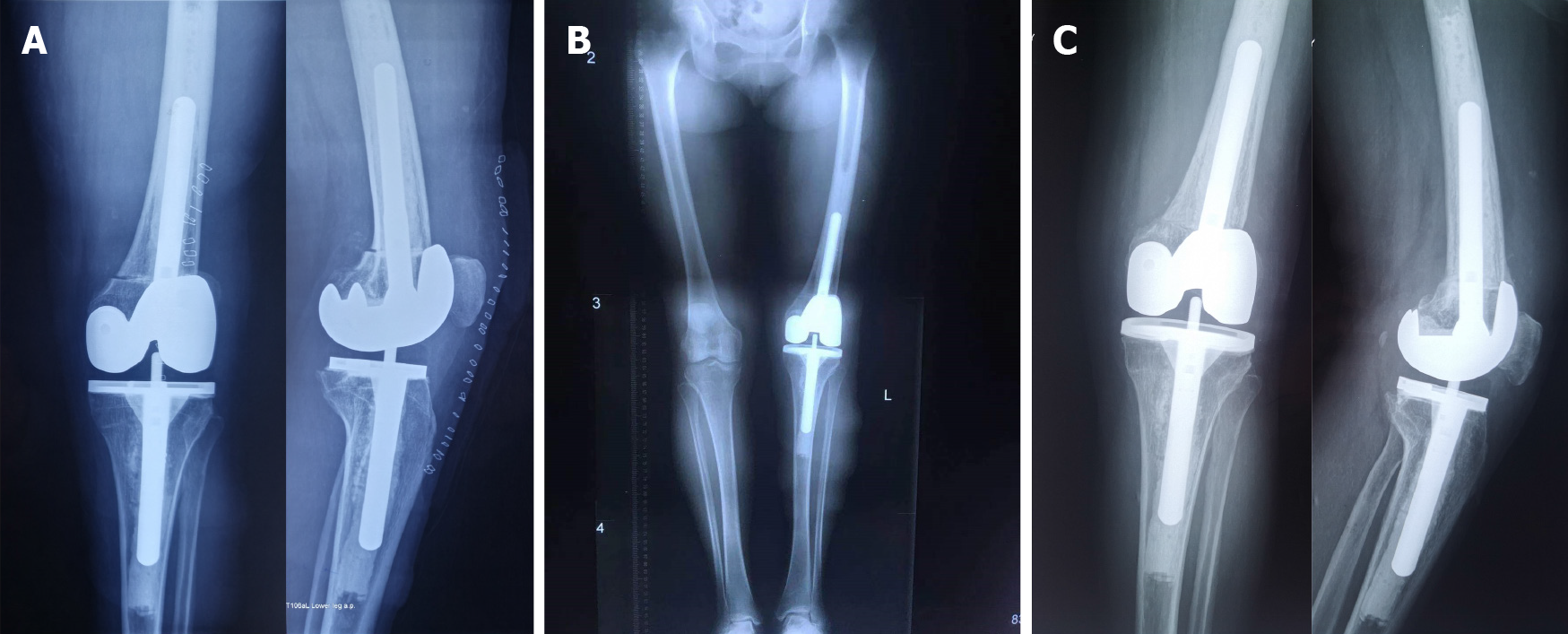Published online Feb 26, 2022. doi: 10.12998/wjcc.v10.i6.1903
Peer-review started: July 20, 2021
First decision: October 16, 2021
Revised: October 29, 2021
Accepted: January 11, 2022
Article in press: January 11, 2022
Published online: February 26, 2022
Processing time: 218 Days and 12 Hours
Surgical treatment of knee osteoarthritis (KOA) complicated by extra-articular deformity has always been controversial regardless of whether it is simultaneous or staged. Simultaneous total knee arthroplasty (TKA) combined with supra
A 53-year-old Chinese woman complained of left knee pain for 6 years that worsened for 4 mo during her visit on April 3, 2020, accompanied by instability in walking, which seriously affected quality of life. According to her medical history and preoperative imaging, the patient was diagnosed with left KOA with varus deformity. We used the angular center of rotation principle for osteotomy of the femur deformity and placed a poststabilized femur prosthesis into the knee joint. At the same time, a 13 mm × 130 mm femur extension rod was used instead of a steel plate to fix the end of the femur osteotomy, reducing the possible complications caused by steel plate implantation and reducing the economic burden on patients. The operation successfully solved two major problems of KOA and varus deformity, and the clinical and imaging evaluation of postoperative follow-up were satisfactory.
TKA and supracondylar femoral osteotomy can be used for simultaneous KOA treatment and deformity correction.
Core Tip: Knee osteoarthritis (KOA) with extra-articular deformities is a common disease, but the choice of surgical methods has always been controversial. The use of total knee arthroplasty alone to achieve the purpose of extra-articular osteotomy and treatment of KOA at the same stage has been rarely reported in the literature. After the operation, the varus deformity was well corrected and the force lines of lower extremities were basically aligned. The follow-up results showed that the prosthesis was firmly fixed and the unstable walking function was significantly improved. This method provides a feasible choice for the surgical treatment of KOA with extra-articular deformity.
- Citation: Xu SM, Li W, Zhang DB, Bi HY, Gu GS. Modified treatment of knee osteoarthritis complicated with femoral varus deformity: A case report. World J Clin Cases 2022; 10(6): 1903-1908
- URL: https://www.wjgnet.com/2307-8960/full/v10/i6/1903.htm
- DOI: https://dx.doi.org/10.12998/wjcc.v10.i6.1903
Knee osteoarthritis (KOA) is a common disease in middle-aged and aged people. The incidence of symptomatic KOA is approximately 8.1%[1]. Pain and walking instability are often the main reasons for patients seeing a doctor. Total knee arthroplasty (TKA) not only effectively relieves pain but also corrects the deformed lower limb line, greatly improving quality of life. However, KOA complicated by extra-articular knee deformity[2], regardless of whether from the femur or tibia, complicates treatment. When TKA is indicated, the extra-articular knee deformity must be taken into account to achieve satisfactory ligament balance. Therefore, osteotomy should be performed as a separate procedure before TKA or during TKA. To our knowledge, descriptions of simultaneous TKA combined with femoral supracondylar osteotomy without plate for the treatment of KOA complicated by femoral varus deformity are rare. This paper discusses such a case in detail.
A 53-year-old Chinese woman complained of left knee pain for 6 years that worsened for 4 mo before her visit on April 3, 2020.
Six years ago, she had left knee pain accompanied by varus deformity of the knee and walking instability, but she did not receive systematic treatment. Four months earlier, the patient’s left knee joint pain and walking instability worsened, seriously affecting her quality of life.
The patient denied any previous medical history of the left knee or surgery.
The patient had no specific personal or family history.
The following physical metrics were examined: Claudius gait, varus deformity of the left knee, knee varus stress test (+), lateral stress test (-), anterior drawer test (-), hospital for special surgery knee score (HSS) score (46 points, 10 points for pain and 11 points for function).
Laboratory examinations showed no obvious abnormalities.
Knee radiographs revealed KOA (Figure 1A). The angle of the lower limbs was measured by long-leg weight-bearing radiography before surgery (Figure 1B), in which the hip–knee–ankle angle was 163°, the mechanical lateral distal femoral angle was 103°, the mechanical proximal medial angle of the tibia was 89.5°, and the varus angle was 17°. The CORA of the left femur was at the level of the upper edge of the patella.
Based on the history and preoperative imaging examination, this patient was diagnosed with left KOA complicated by femoral varus deformity.
Surgical plans were made to treat the KOA and correct the varus deformity by simultaneous TKA and femoral osteotomy to achieve an optimal surgical effect.
During surgery, the anterior median incision of the left knee joint was chosen to open the joint capsule, release the medial tissue to the upper part of the medial tibia foot insertion point, and release the posterior medial angle to the posterior joint capsule. Osteotomy was performed on the femoral condyle according to the preoperative plan. At the level of the upper edge of the patella on the femoral condyle, a 2.5-mm Kirschner wire was drilled from the inside out along the direction parallel to the articular surface of the distal femur. Next, another 2.5-mm Kirschner wire was drilled diagonally along the 15° valgus angle of the previous Kirschner wire. Finally, the two wires were intersected in the medial femoral bone cortex. The 15° wedge was removed along the direction of the Kirschner wire using a pendulum saw (Figure 2A). The bilateral osteotomy ends were reduced, and the other two Kirschner wires were inserted diagonally through the inner and outer parts of the femoral condyle for temporary fixation. The varus deformity of the knee joint was corrected, and the line of gravity of the lower limb was restored satisfactorily (Figure 2B). TKA was performed after completion of orthopedic surgery. An intramedullary fixation system was used for the distal femur. The medullary cavity was drilled from a position 0.5 cm anterior to the attachment point of the posterior cruciate ligament in the intercondylar fossa. A T-shaped rod was inserted, and an osteotomy device was installed setting at 5° valgus. The distal femur osteotomy thickness was approximately 9 mm. Anteroposterior condylar osteotomy (external rotation of 3°) and anteroposterior oblique osteotomy were performed, and the medullary cavity was re-expanded to ensure that the 13-mm extension rod could enter. The proximal tibia was fitted with an extramedullary positioning system, and the osteotomy was kept perpendicular to the tibial force line. The lowest point of the tibial plateau was taken as the reference. The osteotomy angle was tilted backward 5°, and the osteotomy thickness of the tibia was 2 mm. The knee joint was straightened, and then a 10-mm gap measuring block was inserted to measure the extension and flexion gaps. The medial and lateral collateral ligaments and the posteromedial angle were released to ensure the balance of the extension and flexion gaps, and the medullary cavity was also expanded to ensure the entry of the 13-mm extension rod. After reaming on both sides, cement was placed, and the joint prosthesis was implanted. Based on previous tests, a femoral extension rod of 130 mm was found to be the most effective for fixation of femoral osteotomy ends. A posterior stabilized femoral prosthesis (PFC), a 13 mm × 130 mm femoral extender rod, a 10-mm tibial spacer, a tibial platform (PFC) SZ 3, and a 13 mm × 60 mm tibial extender rod (DePuy Orthopaedics) were installed. After reduction, it was tested again to confirm that the line of gravity of the lower limb, the inner and outer soft tissue and the patellar movement trajectory were satisfactory, and femoral osteotomy ends at the orthodontic place were firmly fixed.
After the operation, the patient was in good condition without any discomfort. Postoperative radiographs showed that the prosthesis was in good position and that the varus deformity was corrected (Figure 3A and B). Eight months after the operation, re-examination showed that the prosthesis was firmly fixed and in good position, and the fracture line at the distal femoral osteotomy was blurred (Figure 3C). The patient’s walking instability was significantly improved. The HSS score was 86, including 25 points for pain and 22 for function.
For advanced KOA, surgery is the most effective treatment. However, for patients with KOA with extra-articular deformities, the choice of surgical approach, especially the corrective osteotomy and total knee replacement as a single-stage or two-stage procedure, remains controversial[3]. The following treatment modalities are usually chosen: (1) Plate fixation after a simple femoral or tibial osteotomy[4,5]; (2) Treatment with TKA (intra-articular compensatory osteotomy); (3) Staged corrective osteotomy and delayed TKA; and (4) Simultaneous total knee replacement combined with plate compression fixation after osteotomy. These four surgical procedures are aimed at a fixed population and all have good clinical outcomes, but there are also some deficiencies. The first modality is appropriate for delaying the patient’s years of joint replacement, but is appropriate for younger patients with less severe OA. The second modality requires asymmetric intra-articular osteotomy and ligament balancing to correct lower extremity force lines, but is limited by the site and severity of deformity, which is often ineffective for severe extra-articular deformities[6]. The third modality prolongs patient hospitalization and recovery time, increases the number of procedures, and also increases the odds of incisional infection and economic burden. The fourth procedure performed better than the previous several, especially for KOA with a deformity angle > 20°, which avoids excessive osteotomy within the joint and restores the lower limb force lines [7,8], but it increases the economic burden as well as the risk of possible consolidation with plate implantation.
From the perspective of patients, a single-stage operation should be a priority. In this case, the preoperative data showed that the patient had a femoral varus deformity[9], and the angle of the deformity was 17°. Although it has been reported that KOA with extra-articular deformities < 20° on the coronal plane can be compensated by increasing intra-articular osteotomy[10], compensatory osteotomy may cause iatrogenic ligament instability. Patients with medial collateral ligament contracture and lateral collateral ligament relaxation need soft tissue release during the operation, which further increases the probability of iatrogenic ligament injury or instability. Therefore, extra-articular osteotomy is considered to correct the deformity. Nha et al[11] pointed out that the incidence of postoperative hinge fracture in single-plane tibial wedge osteotomy is lower than that in double-plane tibial osteotomy. It has also been documented that patients with varus deformity tend to retain residual deformity within 0° ± 3° postoperatively, contributing to functional improvement and increased prosthetic life[12]. Therefore, the upper edge of the supracondylar patella of the femur was selected to maintain a 15° valgus angle for a single-plane wedge osteotomy.
As for the internal fixation method of osteotomy site, there is no significant difference between plate fixation and intramedullary fixation in reoperation rate [13]. However, it has been reported that the extension rod plays a role in the treatment of prosthesis loosening, bone mass difference and fracture morphology, and can improve the stability of periprosthesis fracture revision surgery. Stability provides better opportunities for early mobilization and long-term osseointegration[14]. The femoral side application of prosthesis extension rods in ensuring length belongs to intramedullary fixation, differing from the eccentric fixation of plates, which guarantees mechanical stability, and allows early functional exercise of patients.
Compared with the two-stage operation, single-stage surgical intervention can reduce the surgical damage to patients, accelerate recovery time, and avoid the risks that secondary anesthesia poses to patients. Meanwhile, using intramedullary fixation with extended rods also avoids a series of internal fixation complications caused by plate fixation applied after osteotomy, as the plates require larger incisions and greater soft tissue destruction, which are unfavorable for bone healing at the osteotomy end. The problem is solved for patients in terms of both clinical efficacy and economic cost. Using TKA alone, which achieves the two purposes of extra-articular osteotomy and KOA treatment, has rarely been reported in previous studies. However, the use of simultaneous TKA with extra-articular osteotomy is technically difficult. It requires the surgeon to be skilled in the techniques involved in knee revision arthroplasty.
This surgical approach has some limitations and cannot be applied to all knee deformities. Precise surgical protocols should be developed based on detailed evaluation of different individual cases. However, this surgical approach provides a feasible choice for the surgical treatment of KOA combined with extra-articular deformities. This is only a preliminary report, and studies with a higher level of evidence must be performed to validate our findings.
This is believed to be the first report of simultaneous TKA combined with supracondylar osteotomy without a plate for treatment of KOA complicated by femoral varus deformity. This method reduces the surgical trauma and economic burden of patients, and has a good clinical outcome. This procedure represents a promising option to treat KOA complicated by femoral varus deformity.
Provenance and peer review: Unsolicited article; Externally peer reviewed.
Peer-review model: Single blind
Specialty type: Orthopedics
Country/Territory of origin: China
Peer-review report’s scientific quality classification
Grade A (Excellent): 0
Grade B (Very good): B
Grade C (Good): C
Grade D (Fair): 0
Grade E (Poor): 0
P-Reviewer: Velikova TV S-Editor: Liu JH L-Editor: A P-Editor: Liu JH
| 1. | Tang X, Wang S, Zhan S, Niu J, Tao K, Zhang Y, Lin J. The Prevalence of Symptomatic Knee Osteoarthritis in China: Results From the China Health and Retirement Longitudinal Study. Arthritis Rheumatol. 2016;68:648-653. [RCA] [PubMed] [DOI] [Full Text] [Cited by in Crossref: 179] [Cited by in RCA: 307] [Article Influence: 34.1] [Reference Citation Analysis (0)] |
| 2. | Rossi R, Cottino U, Bruzzone M, Dettoni F, Bonasia DE, Rosso F. Total knee arthroplasty in the varus knee: tips and tricks. Int Orthop. 2019;43:151-158. [RCA] [PubMed] [DOI] [Full Text] [Cited by in Crossref: 19] [Cited by in RCA: 42] [Article Influence: 6.0] [Reference Citation Analysis (0)] |
| 3. | Sculco PK, Kahlenberg CA, Fragomen AT, Rozbruch SR. Management of Extra-articular Deformity in the Setting of Total Knee Arthroplasty. J Am Acad Orthop Surg. 2019;27:e819-e830. [RCA] [PubMed] [DOI] [Full Text] [Cited by in Crossref: 18] [Cited by in RCA: 20] [Article Influence: 3.3] [Reference Citation Analysis (0)] |
| 4. | Liu X, Chen Z, Gao Y, Zhang J, Jin Z. High Tibial Osteotomy: Review of Techniques and Biomechanics. J Healthc Eng. 2019;2019:8363128. [RCA] [PubMed] [DOI] [Full Text] [Full Text (PDF)] [Cited by in Crossref: 30] [Cited by in RCA: 73] [Article Influence: 12.2] [Reference Citation Analysis (0)] |
| 5. | Peng H, Ou A, Huang X, Wang C, Wang L, Yu T, Zhang Y. Osteotomy Around the Knee: The Surgical Treatment of Osteoarthritis. Orthop Surg. 2021;13:1465-1473. [RCA] [PubMed] [DOI] [Full Text] [Full Text (PDF)] [Cited by in Crossref: 13] [Cited by in RCA: 59] [Article Influence: 14.8] [Reference Citation Analysis (0)] |
| 6. | Loures FB, Correia W, Reis JH, Pires E Albuquerque RS, de Paula Mozela A, de Souza EB, Maia PV, Barretto JM. Outcomes after knee arthroplasty in extra-articular deformity. Int Orthop. 2019;43:2065-2070. [RCA] [PubMed] [DOI] [Full Text] [Cited by in Crossref: 18] [Cited by in RCA: 9] [Article Influence: 1.5] [Reference Citation Analysis (0)] |
| 7. | Catonné Y, Sariali E, Khiami F, Rouvillain JL, Wajsfisz A, Pascal-Moussellard H. Same-stage total knee arthroplasty and osteotomy for osteoarthritis with extra-articular deformity. Part I: Tibial osteotomy, prospective study of 26 cases. Orthop Traumatol Surg Res. 2019;105:1047-1054. [RCA] [PubMed] [DOI] [Full Text] [Cited by in Crossref: 15] [Cited by in RCA: 15] [Article Influence: 2.5] [Reference Citation Analysis (0)] |
| 8. | Catonné Y, Khiami F, Sariali E, Ettori MA, Delattre O, Tillie B. Same-stage total knee arthroplasty and osteotomy for osteoarthritis with extra-articular deformity. Part II: Femoral osteotomy, prospective study of 6 cases. Orthop Traumatol Surg Res. 2019;105:1055-1060. [RCA] [PubMed] [DOI] [Full Text] [Cited by in Crossref: 12] [Cited by in RCA: 11] [Article Influence: 1.8] [Reference Citation Analysis (0)] |
| 9. | Thienpont E, Schwab PE, Cornu O, Bellemans J, Victor J. Bone morphotypes of the varus and valgus knee. Arch Orthop Trauma Surg. 2017;137:393-400. [RCA] [PubMed] [DOI] [Full Text] [Cited by in Crossref: 73] [Cited by in RCA: 110] [Article Influence: 13.8] [Reference Citation Analysis (0)] |
| 10. | Tanzer M, Makhdom AM. Preoperative Planning in Primary Total Knee Arthroplasty. J Am Acad Orthop Surg. 2016;24:220-230. [RCA] [PubMed] [DOI] [Full Text] [Cited by in Crossref: 50] [Cited by in RCA: 58] [Article Influence: 6.4] [Reference Citation Analysis (0)] |
| 11. | Nha KW, Shin MJ, Suh DW, Nam YJ, Kim KS, Kyung BS. Uniplane medial opening wedge high tibial osteotomy relative to a biplane osteotomy can reduce the incidence of lateral-hinge fracture. Knee Surg Sports Traumatol Arthrosc. 2020;28:1436-1444. [RCA] [PubMed] [DOI] [Full Text] [Cited by in Crossref: 6] [Cited by in RCA: 9] [Article Influence: 1.8] [Reference Citation Analysis (0)] |
| 12. | Vandekerckhove PTK, Matlovich N, Teeter MG, MacDonald SJ, Howard JL, Lanting BA. The relationship between constitutional alignment and varus osteoarthritis of the knee. Knee Surg Sports Traumatol Arthrosc. 2017;25:2873-2879. [RCA] [PubMed] [DOI] [Full Text] [Cited by in Crossref: 27] [Cited by in RCA: 43] [Article Influence: 5.4] [Reference Citation Analysis (0)] |
| 13. | Gausden EB, Lim PK, Rabonivich A, Shaath MK, Mitchell PM, Hartline B, Achor TS, Warner SJ. Outcomes of periprosthetic distal femur fractures following total knee arthroplasty: Intramedullary nailing vs plating. Injury. 2021;52:1875-1879. [RCA] [PubMed] [DOI] [Full Text] [Cited by in Crossref: 5] [Cited by in RCA: 10] [Article Influence: 2.5] [Reference Citation Analysis (0)] |
| 14. | Rodríguez-Merchán EC. The stiff total knee arthroplasty: causes, treatment modalities and results. EFORT Open Rev. 2019;4:602-610. [RCA] [PubMed] [DOI] [Full Text] [Full Text (PDF)] [Cited by in Crossref: 44] [Cited by in RCA: 37] [Article Influence: 6.2] [Reference Citation Analysis (0)] |











